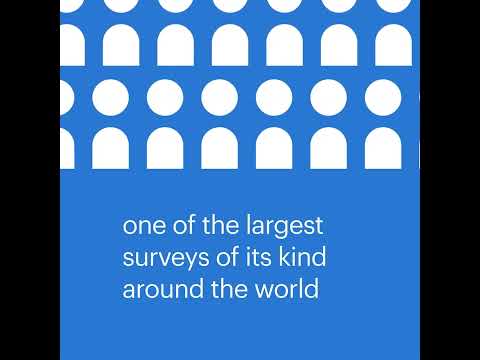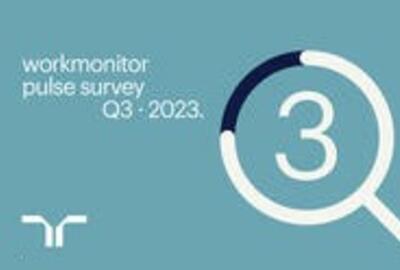It’s 20 years since our first Workmonitor report and we’re taking this significant moment to look back on how the world of employment has evolved.
The past 20 years have seen the rise of the smartphone, social media, the gig economy and a global pandemic, all of which have shaped and refined the way we work.
With so many technological and ideological changes, it is only natural for the employee experience to evolve too. That’s why tracking these changes is so vital to understanding the evolution of employment.
Two decades of Workmonitor surveys show us that one of the biggest shifts is the growing desire to achieve a thriving career that also complements a thriving home life.
Here are three key findings that have altered work-life balance over the years and redefined employment.
how technology can hinder work-life balance
Apple launched its first iPhone in 2007. While not the first smartphone, it ushered in a new era of carrying computing power in our pockets that previously only desktops or laptops could have provided.
Yet, instead of freeing up time and untethering employees from working in a fixed location, the launch coincided with the rise of an “always on” work culture; Randstad Workmonitor 2007 survey respondents reported a growing trend of work creeping into people’s home lives, with many saying working overtime had become the norm.
The average working hours per employee had been in decline for years. But by the time the financial crisis of 2008/09 had begun to subside, many respondents said they were seeing employer expectations grow. Over half of those surveyed said their workload had increased, and a third had received emails or calls outside of office hours, making it harder to switch off.
With this came calls for change and, by 2012, four out of every five employees wanted a better work-life balance. But employers were slow to respond and, by 2018, 64% of respondents wanted to work remotely but did not have the option, until the global pandemic response forced hundreds of millions of people to work from home.
flexibility with technology
Technology may have been partly responsible for the always-on culture, but it has also opened up a new way to work. Company culture can act as a barrier to technological innovation, though. Even today, many employees — particularly in blue- and grey-collar roles — are still looking to employers to embrace more of these technologies, not just because they help work processes, but to increase flexibility and restore work-life balance.
Randstad’s latest Workmonitor report shows the extent of progress as of 2023, in which 78% of survey respondents said they have a good work-life balance, and a majority would not accept a new job if it negatively impacted this. The shift in attitudes toward work has changed permanently, the report says, particularly for the newest working generations, who have the highest expectations and strongest appetite for a healthy work-life balance.
And technology can be a powerful tool in helping people balance work and life. Jasmine “Chayil” Burse, over at Randstad USA, is a single parent of four, and organization is at the heart of both her work and personal life.
“I utilize calendars, spreadsheets, Google Docs and templates — my personal calendar and work calendar are integrated into a single planner for ease of reference, which helps me to be efficient and detail-oriented.”
changing approaches to workplace culture
Studies from 2010, and many that came after, show happier people are around 12% more productive. And given that work-life balance is so important to employees today, companies are targeting initiatives that will help achieve this — introducing family-friendly policies like paid parental leave, flexible hours and even on-site childcare facilities.
This increase in leadership focus on mental health, diversity and inclusivity, and flexibility around jobs has meant that, for many, work-life balance has improved over time.
Randstad’s Judith Cederhout, who is based in the Netherlands, says that as an employability adviser, she has coached many colleagues on how to deal with stress and burnout.
“It starts with knowing your 'personal terms' well. How do you function at your best? Often I see that recovery starts with realizing that you can take control of both work and private life yourself. It takes courage and good managerial support.
“I also try to practice what I preach, and for me, sleep is key to my well-being. If this is in order, I can be a good coach for our colleagues — who are dealing with emotional situations — and combine this with a busy family life; that means learning to say ‘no’ sometimes.”
But not every role has that kind of support — while 52% of white-collar staff reported an increase in flexibility since the pandemic, only 20% of blue-collar staff and 25% of grey-collar talent said the same in a recent Workmonitor Pulse survey.
These revelations could pave the way for blue- or grey-collar workers to receive more flexible benefits in the future, as employers increasingly understand the value of keeping staff happy and leading a balanced life.
addressing work-life balance for all
The evolution of work-life balance has been driven by both technological and ideological innovations, but it is a personal journey too.
Randstad’s Marcin Oziewicz, based in Poland, believes he has finally found the right balance in life.
"After 28 years of employment for various organizations and on my own, I recognize that my career development is just one of the tools to have a fulfilling life. There are so many other ways your life can be meaningful.
"Flexible working hours, good calendar planning, hybrid working models and removing meaningless meetings can all help create balance. They all allow me to think, be active, be creative, be with other people, or simply do nothing."
And, in turn, employers recognize that taking an empathetic approach to people management can create a happier, more productive workforce.
In the past, new technologies that improved how we work were often slow to be adopted, perhaps because the value of happy and empowered teams was not fully understood, and there was less of an imperative to attract and retain skilled staff.
Today, employees are increasingly seeking out employers who understand that modern life may need a little more flexibility than it did 20 years ago.
And, in turn, employers recognize that taking an empathetic approach to people management can create a happier, more productive workforce.








